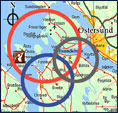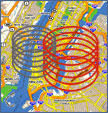

 |
SaTScan™ Software for the spatial, temporal, and space-time scan statistics |  |
|
SaTScan TutorialsFor educational purposes we have developed a set of SaTScan tutorial. These can be used in a class room setting, as part of a course on disease surveillance, spatial epidemiology, medical geography, or spatial statistics. They can also be used for self-study, or as part of a group project. With each tutorial comes a disease data set from New York State. The tutorials have been tested with a live audience as part of university courses and conference workshops. The only pre-requisites for these tutorials are a basic understanding of statistics and epidemiology at the undergraduate level. SaTScan Tutorial #1: Purely Spatial Poisson Scan Statistic for Cancer IncidenceIn this first SaTScan tutorial, the purely spatial scan statistic is used to analyze the geographical distribution of breast cancer incidence in New York State, in order to determine if there are any geographical clusters of breast cancer incidence. The tutorial teaches how to properly format and import the data, how to select parameter settings, how to run a purely spatial scan statistic with the Poisson probability model, how to interpret the results, and how to display the detected geographical clusters using Google Earth. The tutorial was designed for SaTScan v9.4, but can also be used with subsequent versions.
SaTScan Tutorial #2: The Bernoulli Spatial Scan Statistic for Birth Defect DataIn the second SaTScan tutorial, the purely spatial scan statistic is used to analyze the geographical distribution of congenital malformation (birth defects) incidence in New York State, in order to determine if there are any geographical clusters of birth defects incidence. This tutorial walks you through the process of properly formatting and importing the data. It also shows you how to select parameter settings, how to run a purely spatial scan statistic with the Bernoulli probability model, how to interpret the results, and how to display the detected geographical clusters using Google Earth. The tutorial was designed for SaTScan v9.4, but can also be used with subsequent versions.
SaTScan Tutorial #3: Advanced OptionsIn this third SaTScan tutorial, the purely spatial scan statistic is used to analyze the geographical distribution of female breast cancer incidence in New York State, in order to determine if there are any geographical clusters of breast cancer incidence. A purely spatial Poisson model will be used but we will describe and explore many of the advanced features available in SaTScan. While we illustrate these advanced features using the Poisson model, most of them are also available for the other probability models in SaTScan. The tutorial was designed for SaTScan v9.4, but can also be used with subsequent versions.
SaTScan Tutorial #4: Ordinal Scan Statistic for Identifying Unusual Cancer Stage PatternsIn this tutorial, we use the purely spatial scan statistic with the ordinal statistical model to analyze the geographical variation of colorectal cancer diagnosis in New York State, USA, in order to determine if there are any geographical clusters of either earlier or more advanced stage at diagnosis. That is, we will determine if there are any geographical areas where the distribution of cancer stage is unusually skewed relative to the statewide average. The tutorial was designed for SaTScan v9.4, but can also be used with subsequent versions.
SaTScan Tutorial #5: Multinomial Scan Statistic for Identifying Unusual Population Age StructuresIn this tutorial, we use the purely spatial scan statistic with the multinomial statistical model to analyze the geographical variation in age-specific populations in the United States in order to determine if there are any geographical clusters of populations which are unusually young, old, middle-aged, or any combination of these. The tutorial was designed for SaTScan v9.5, but can also be used with subsequent versions.
SaTScan Tutorial #6: Outbreak DetectionSince 2014, the Bureau of Communicable Disease at the New York City Department of Health and Mental Hygiene has analyzed reportable communicable diseases daily using SaTScan. The Bureau of Communicable Disease's systems have quickly detected outbreaks of salmonellosis, legionellosis, shigellosis, and COVID-19. This tutorial details system design considerations, including geographic and temporal data aggregation, study period length, inclusion criteria, whether to account for population size, network location file setup to account for natural boundaries, probability model (eg, space-time permutation), day-of-week effects, minimum and maximum spatial and temporal cluster sizes, secondary cluster reporting criteria, signaling criteria, and distinguishing new clusters versus ongoing clusters with additional events. We describe how to fine-tune the system when the detected clusters are too large to be of interest or when signals of clusters are delayed, missed, too numerous, or false. We demonstrate low-code techniques for automating analyses and interpreting results through built-in features on the user interface (eg, patient line lists, temporal graphs, and dynamic maps), which became newly available with the July 2022 release of SaTScan version 10.1.
|